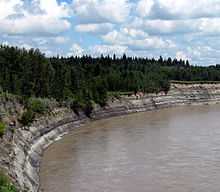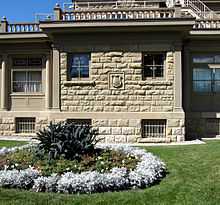Paskapoo Formation
| Paskapoo Formation Stratigraphic range: Paleocene | |
|---|---|
|
| |
| Type | Geological formation |
| Underlies | Tertiary gravel, Quaternary sediments, present erosional surface |
| Overlies | Scollard Formation, Coalspur Formation |
| Thickness | up to 600 metres (1,970 ft)[1] |
| Lithology | |
| Primary | mudstone, siltstone, sandstone |
| Other | conglomerate, coal |
| Location | |
| Coordinates | 52°21′15″N 113°57′49″W / 52.35410°N 113.96373°W |
| Region |
|
| Country |
|
| Type section | |
| Named for | Paskapoo, "blind man" in Cree, from Blindman River |
| Named by | Tyrrell, 1887 |
The Paskapoo Formation is a stratigraphic unit of middle to late Paleocene age in the Western Canada Sedimentary Basin. The Paskapoo underlies much of southwestern Alberta,[2] and takes the name from the Blindman River (paskapoo means "blind man" in Cree). It was first described in outcrops along that river, near its confluence with the Red Deer River north of the city of Red Deer, by J.B. Tyrrell in 1887.[3] It is important for its freshwater aquifers, its coal resources, and its fossil record, as well as having been the source of sandstone for the construction of fire-resistant buildings in Calgary during the early 1900s.
Lithology
The Paskapoo Formation is of fluvial origin and consists primarily of sandstones, siltstones and mudstones, with lesser amounts of pebble-conglomerate and coal, and minor bentonite. The sediments were derived from the Canadian Cordillera during tectonic uplift and erosion in the late stages of the Laramide Orogeny, and were transported eastward by river systems and deposited in fluvial and floodplain environments.[4]
Environment of deposition
The sandstones were deposited in fluvial channels. They are cross-bedded, medium- to coarse-grained, and locally conglomeratic. The siltstones and mudstones represent crevasse splay, overbank and shallow pond environments. They include plant fossils, rooted horizons and paleosols.[5] Carbonaceous mudstones and coaly beds that represent oxygen-poor, swampy settings are thin and discontinuous, but common. Thick coal seams that formed in well-developed swamps are present only in the youngest portion of the formation, which is preserved near Hinton.[4]
Stratigraphy

The base of the Paskapoo Formation, designated the Haynes Member, consists primarily of cliff-forming sandstones and pebble-conglomerates, interbedded with lesser amounts of siltstone and mudstone. In the overlying Lacombe Member, siltstones and mudstones are dominant, with interbeds of fine-grained sandstone, carbonaceous mudstones, paleosols, and thin coals. The Dalehurst Member at the top of the formation consists of the Obed coal zone.[6] The Dalehurst strata are similar to those of the Lacombe Member, but the sequence includes up to six coal seams, with individual seams up to 5 metres (20 ft) thick.[7]
Although some early workers included the underlying Scollard Formation as the lower part of the Paskapoo, the two are now treated separately.[4]

Distribution
The Paskapoo Formation underlies much of southwestern Alberta.[2] It is thickest in the foothills of the Canadian Rockies, and thins eastward to the 112th meridian west in the plains. The formation is more than 750 metres (2,460 ft) thick in the foothills,[8] and about 600 metres (1,970 ft) near Calgary.[1] It is assumed that it originally reached thicknesses as great as 1,000 metres (3,280 ft) in some areas, prior to erosion.
The formation is exposed at the surface along a trend that extends from Calgary to west of Edmonton. Good outcrops can be seen in the eastern reaches of the foothills, and along the Bow River in and around Calgary (for example at Paskapoo Slopes), the Red Deer River near Red Deer, the North Saskatchewan River west of Edmonton, and the Athabasca River. The Dalehurst Member is an erosional remnant and is confined to an area adjacent to the foothills near Hinton and Obed.[6]
Relationship to other units
The Paskapoo Formation underlies the present day erosional surface, and in many areas it is exposed in outcrop. Cover, where present, consists of Quaternary sediments or, on a few localized plateaus, of younger Tertiary gravels.[4]
The Paskapoo rests on the Scollard Formation in the Alberta plains, and on the equivalent Coalspur Formation in the Alberta foothills. The lower boundary has been defined as the erosional base of the first prominent sandstone above the Ardley coal zone of the Scollard Formation.[9] It has been established that, in the type area near Red Deer, this erosional surface represents a hiatus of about 1-2 million years.[4] In the foothills, the contact with the underlying Coalspur Formation is less distinctive, but it is again placed at the base of the first dominantly sandstone unit overlying a dominantly coal and mudstone unit.[8]
The Paskapoo grades into the equivalent Porcupine Hills Formation south of Calgary.[2] It is correlated with upper part of the Ravenscrag Formation of southern Saskatchewan and the Fort Union Formation of Montana and North Dakota, which are not contiguous with it but are of similar age.[10]
Age
The middle to late Paleocene age of the Paskapoo Formation is based primarily on Paskapoo mammal fossils, which indicate North American land mammal ages of middle to late Tiffanian,[11] and is supported by detailed palynostratigraphic and magnetostratigraphic studies.[4][12] It is equivalent to a radiometric age of approximately 62.5 to 58.5 million years.[4]
Paleontology

The Paskapoo Formation contains remains of vertebrates,[13] especially mammals, and plants. Material from the following groups of mammals has been reported from the Paskapoo Formation: Multituberculata, Marsupicarnivora, Lyptophyla, Dermoptera, Primates, Carnivora, Condylartha, and Pantodonta, as well as the small, possibly venomous mammal Bisonalveus.[11] The Paskapoo has also yielded articulated and fragmentary skeletons of freshwater fish, impressions of insect wings and larvae, and shells of freshwater molluscs.[5]
Plant fossils were first collected from the Paskapoo Formation by Tyrrell in 1886,[3] and since that time a wide variety have been described. These include specimens of the ferns Azolla,[14] Onoclea,[15] and Speirseopteris;[16] the conifers Metasequoia (including Metasequoia foxii) and Glyptostrobus; and the dicots Palaeocarpinus[17] (a member of the birch family), Cercidiphyllum (including Joffrea[18]), Platanus,[19] and Beringiaphyllum[20] (a relative of dogwoods).
Resources
Building stone

During the early 1900s, outcrops of Paskapoo sandstone in the Calgary area were quarried for building stone due to the requirement for fire-resistant buildings following the Calgary Fire of 1886. Many of Calgary's early landmark buildings, such as the Lougheed House, Burns Manor, and some of the buildings along Stephen Avenue, were built using Paskapoo sandstone, and Calgary became known as the Sandstone City.[21] Paskapoo sandstone is still used in landscaping in the Calgary area today.
Coal
Coal is mined from the Obed coal zone in the Paskapoo Formation near Hinton. It is of high-volatile bituminous rank with a low sulphur content, and it is shipped to markets in eastern Canada and the Pacific Rim.[7]
Groundwater
Paskapoo Formation aquifers are a very important source of water for irrigation and drinking in southwestern Alberta.[4]
References
- ↑ 1.0 1.1 Lexicon of Canadian Geologic Units. "Paskapoo Formation". Retrieved 2009-05-30.
- ↑ 2.0 2.1 2.2 Prior, G. J., Hathaway, B., Glombick, P.M., Pana, D.I., Banks, C.J., Hay, D.C., Schneider, C.L., Grobe, M., Elgr, R., and Weiss, J.A. (2013). "Bedrock Geology of Alberta. Alberta Geological Survey, Map 600". Retrieved 2013-08-13.
- ↑ 3.0 3.1 Tyrrell, J.B., 1887. Report on a part of northern Alberta and portions of adjacent Districts of Assiniboia and Saskatchewan; Geological Survey of Canada, Annual Report 1886, v.11, Part E, p.1-176
- ↑ 4.0 4.1 4.2 4.3 4.4 4.5 4.6 4.7 Hamblin, A.P. (2004). "Paskapoo-Porcupine Hills Formation in western Alberta: Synthesis of regional geology and resource potential. Geological Survey of Canada, Open File 4679.". Retrieved 2013-08-01.
- ↑ 5.0 5.1 Hoffman, G.L. and Stockey, R.A., 1999. Geological setting and paleobotany of the Joffre Bridge Roadcut fossil locality (Late Paleocene), Red Deer Valley, Alberta. Canadian Journal of Earth Science, 36: 2073-2084.
- ↑ 6.0 6.1 Demchuk, T.D. and Hills, L.V., 1991. A re-examination of the Paskapoo Formation in the central Alberta Plains: the designation of three new members. Canadian Journal of Earth Science 27: 1263-1269.
- ↑ 7.0 7.1 Mossop, G.D. and Shetsen, I., (compilers), Canadian Society of Petroleum Geologists (1994). "The Geological Atlas of the Western Canada Sedimentary Basin, Chapter 33: Coal Resources of the Western Canada Sedimentary Basin". Retrieved 2013-08-01.
- ↑ 8.0 8.1 Lerbekmo, J.F. and Sweet, A.R., 2008. Magnetobiostratigraphy of the continental Paleocene upper Coalspur and Paskapoo formations near Hinton, Alberta. Bulletin of Canadian Petroleum Geology 56: 118-146.
- ↑ Alberta Geological Survey. "Scollard & Paskapoo Formations". Retrieved 2009-05-30.
- ↑ Mossop, G.D. and Shetsen, I., (compilers), Canadian Society of Petroleum Geologists (1994). "The Geological Atlas of the Western Canada Sedimentary Basin, Chapter 24: Upper Cretaceous and Tertiary strata of the Western Canada Sedimentary Basin". Retrieved 2013-08-01.
- ↑ 11.0 11.1 Fox, R.C., 1990. The succession of Paleocene mammals in western Canada. Geological Society of America, Special Paper 243, pp. 51-70.
- ↑ Lerbekmo, J.F., Demchuk, T.D., Evans, M.E. and Hoye, G.S., 1992. Magnetostratigraphy and biostratigraphy of the continental Paleocene of the Red Deer Valley, Alberta, Canada. Bulletin of Canadian Petroleum Geology, 40: 24-35.
- ↑ Vertebrate track sites of Canada. "Paskapoo Formation". Retrieved 2009-05-30.
- ↑ Hoffman, G.L. and Stockey, R.A., 1994. Sporophytes, megaspores and massulae of Azolla stanleyi from the Paleocene Joffre Bridge locality, Canada. Canadian Journal of Botany, 72: 301-308.
- ↑ Rothwell, G.W. and Stockey, R.A., 1991. Onoclea sensibilis in the Paleocene of North America, a dramatic example of structural and ecological stasis. Review of Palaeobotany and Palynology, 70: 113–124.
- ↑ Stockey R.A., Lantz, T.C. and Rothwell, G.W. 2006. Speirseopteris orbiculata (Thelypteridaceae), a derived fossil filicalean from the Paleocene of western North America. International Journal of Plant Science, 167: 729–736.
- ↑ Sun, F. and Stockey, R.A., 1992. A new species of Palaeocarpinus (Betulaceae) from the Paleocene of Alberta, Canada. International Journal of Plant Science, 153: 136–146.
- ↑ Crane, P.R., and Stockey, R.A. 1985. Growth and reproductive biology of Joffrea speirsii, a Cercidiphyllum-like plant from the Late Paleocene of Alberta, Canada. Canadian Journal of Botany, 63: 340–364.
- ↑ Pigg, K.B. and Stockey, R.A., 1991. Platanaceous plants from the Paleocene of Alberta. Rev. Palaeobot. Palynol. 70:125-146.
- ↑ Manchester, S.R., Crane, P.R. and Golovneva, L.B., 1999. An extinct genus with affinities to extant Davidia and Camptotheca (Cornales) from the Paleocene of North America and eastern Asia. International Journal of Plant Science, 160: 188–207.
- ↑ "The Sandstone City". 2002-11-21. Retrieved 2013-08-04.
| ||||||||||||||